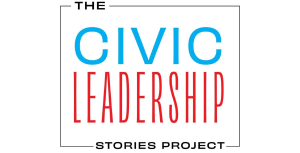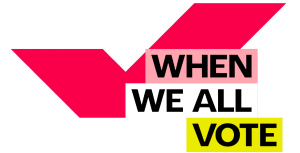CIVIC ENGAGEMENT PORTRAYALS BY TV PLATFORM AND GENRE
About three in ten entertainment TV episodes portray civic themes (civic leadership or civic participation).
In the most-watched entertainment TV shows across platforms and genres, portrayals of civic participation (including civic conversations and actions by both civic professionals and everyday people) show up in only about one-third of episodes (29%). The three major platforms (cable, broadcast, and streaming) are equally likely to showcase civic participation, although broadcast networks rise slightly to the top; 37% of civic participation storylines occur on broadcast networks (ex: ABC), 33% are portrayed on cable (ex: VH1), and 30% on streaming-native networks (ex: Netflix).
Scripted drama is leading the way; nearly half of episodes (47%) with civic engagement themes fall within this genre. There is more opportunity for growth across other genres.


CIVIC PROFESSIONALS
Civic and elected leaders—those who are leaders in politics, public policy, government— are four times less likely to show up in entertainment TV than law enforcement and criminal justice professionals.
How often do civic professionals show up in entertainment TV?
Elected officials, political candidates for elected office, and non-elected government officials/ civil servants are depicted in about one-fifth (21%) of entertainment TV episodes. One in ten (11%) episodes portray elected officials, 8% portray civil servants/non-elected government officials, and 2% show political candidates for elected office. By contrast, the portrayal of law enforcement and criminal justice professionals is nearly double that of politicians and civil servants: four in ten (41%) entertainment TV episodes include people who work in law enforcement and criminal justice. When elected officials, political candidates for elected office, and non-elected government officials/civil servants do show up in entertainment TV episodes, they tend to be White (78%) and men (68%).
While they appear infrequently in entertainment TV episodes, the characters in these civic professional roles are featured in a variety of ways: Political candidates run for a variety of local, state, and federal offices (e.g., City Council, Governor of Oklahoma, President of the United States). Elected officials hold a range of local, state, and federal offices (e.g., mayors, governors, members of Congress, Vice President, President). And non-elected government officials tend to focus on well-known roles at the federal level, such as CIA Director, Chief Scientist at NASA, and head of The Department of Child and Family Services. They are most likely to be seen giving public talks or attending public events, rather than the other tasks and skills associated with civic leadership.
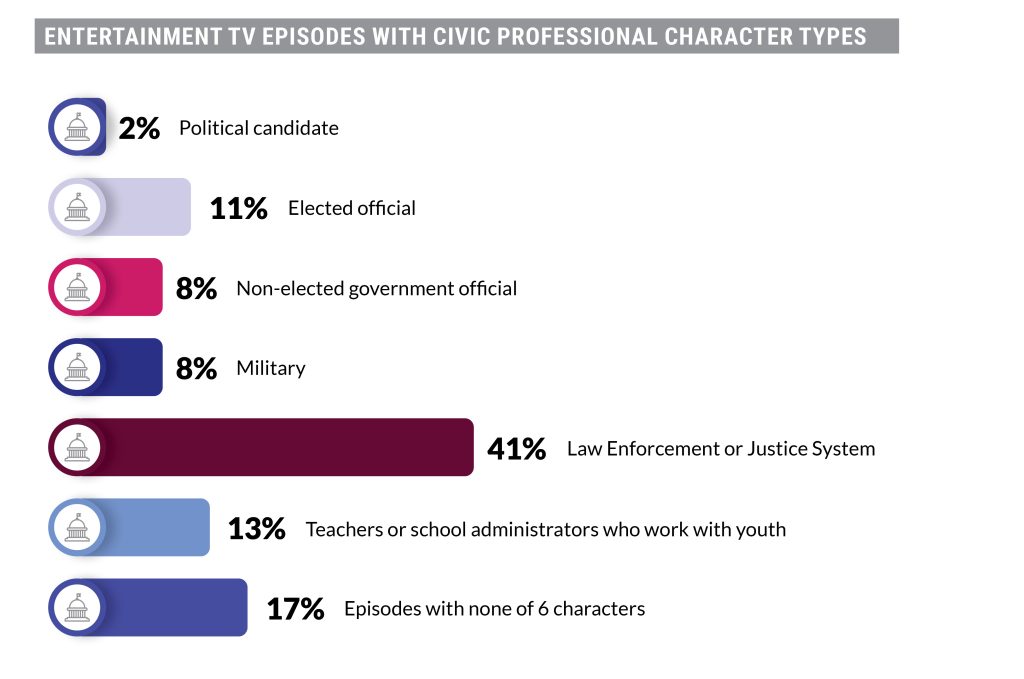
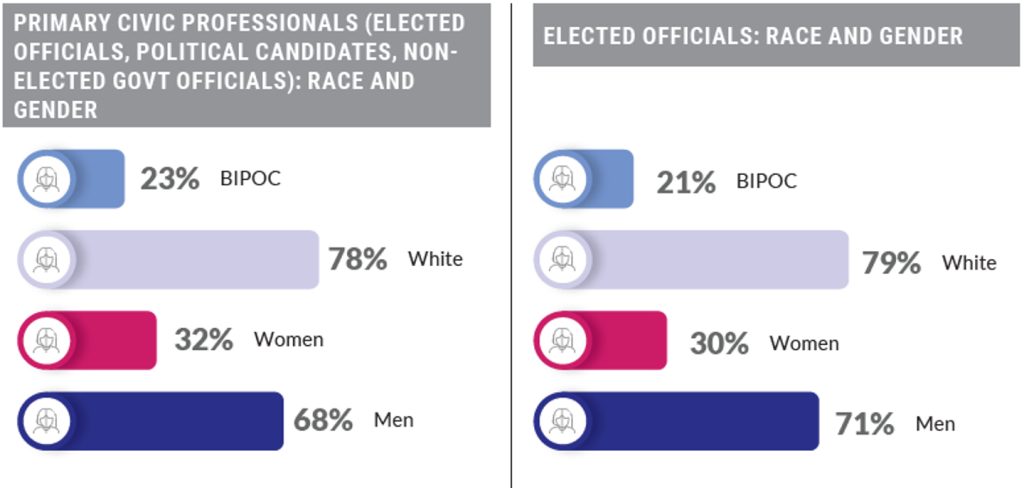

What do primary civic professionals do on screen?
Although seen infrequently, when they do appear in entertainment TV episodes, elected officials, political candidates for elected office, and non-elected government officials/civil servants tend to give public talks or attend public events more than other activities involved in civic leadership jobs. They are the least likely to be depicted as engaging in the legislative and policy making process itself. Politicians and civil servants are twice as likely to be shown engaging in illegal activities than working in policymaking.
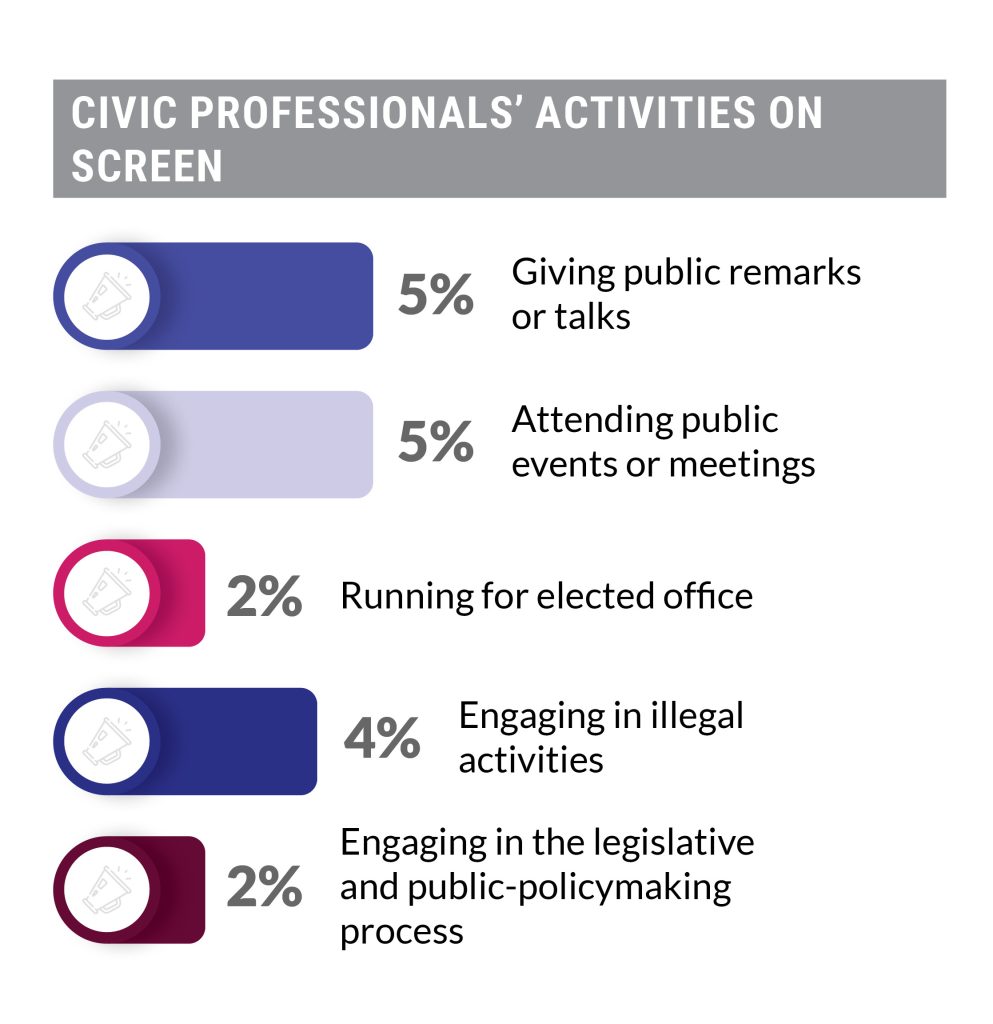
Are civic professionals portrayed with positive or negative traits?
Elected officials, political candidates for elected office, and non-elected government officials/civil servants are equally likely to be portrayed in entertainment TV episodes with positive (competent, professional, honest) and negative (incompetent, corrupt, dishonest) traits. But elected officials are more likely to be portrayed with negative traits than political candidates or non-elected government officials/civil servants.
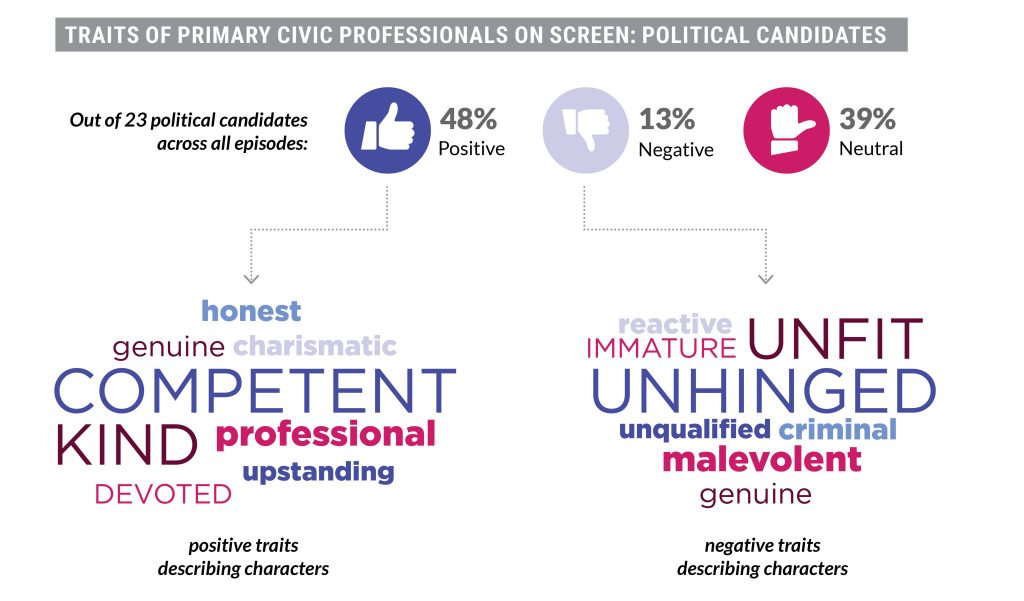
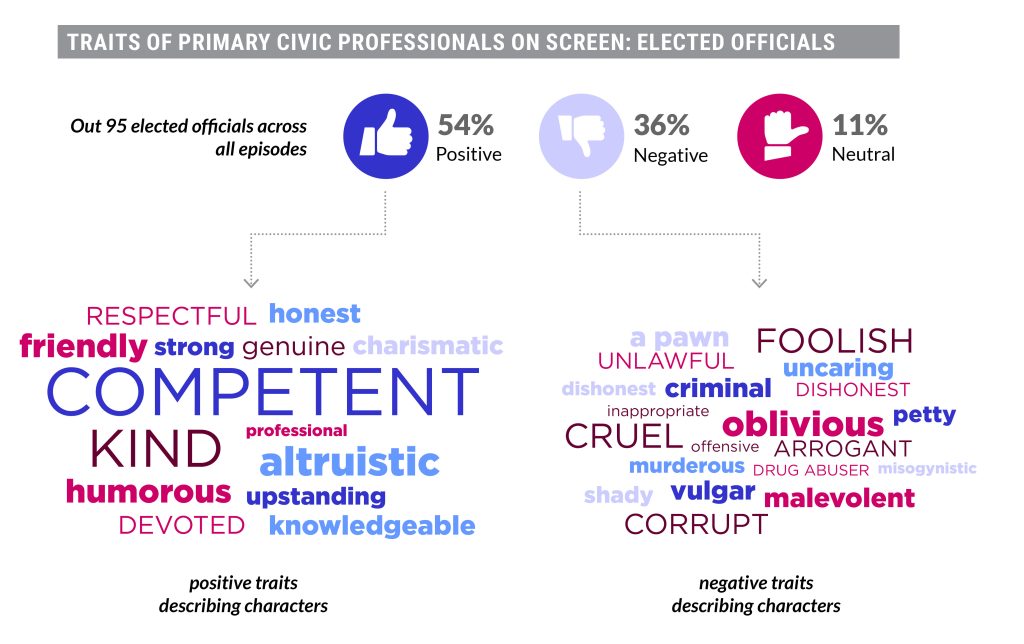

EVERYDAY PEOPLE PARTICIPATING IN CIVIC LIFE
About one-fifth (21%) of entertainment TV episodes portray ordinary people participating in civic life.
In most-watched entertainment TV, everyday people are more likely to engage in civic actions related to topical social issues than electoral politics, although civic behavior of any kind is infrequent. Top civic activities are: volunteering to address issues of public concern or community needs (4% of episodes depicted this behavior), organizing or attending events on issues of public concern or public policy (in 3% of episodes), and giving a talk or speech on issues of public concern or public policy (a little less than 3% of episodes).
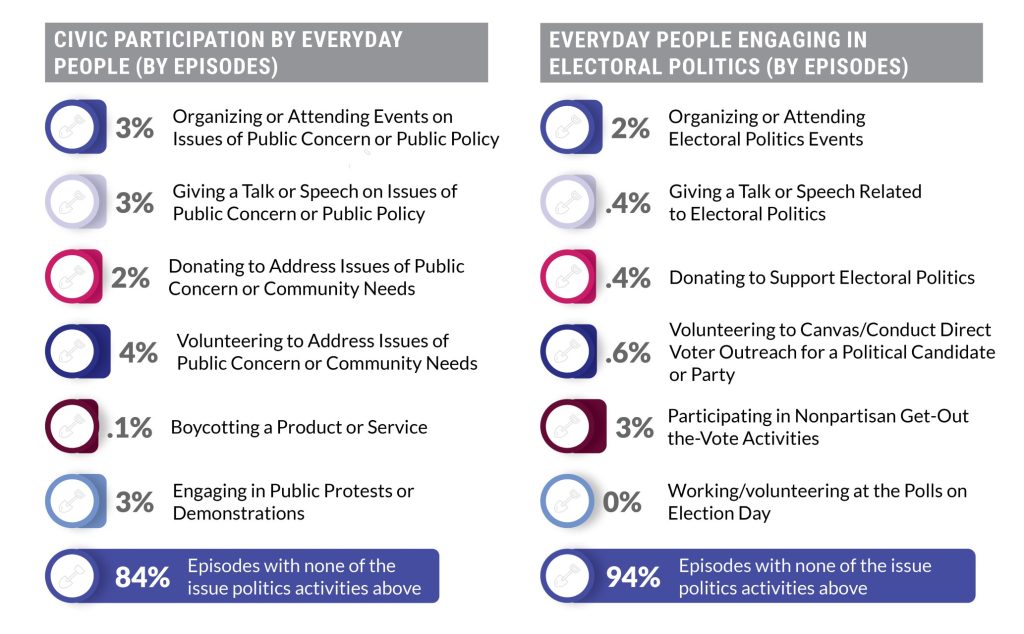
CONVERSATIONS ABOUT CIVIC AND SOCIAL ISSUES
Ordinary people are more likely to be depicted in conversations about civic and social justice issues than electoral politics. Conversations mirror contemporary concerns: mental health and substance abuse, gender violence, racism, and immigration.
Informal conversations about civic and social issues between characters are eight times more likely to focus on issues of social justice concerns than electoral politics (16% vs. 2% of total episodes). Characters’ conversations about issues address a broader range of topics that align with contemporary challenges in American society. The most frequently occurring issue themes aligned with topical areas of public debate and concern: racism, racial and social disparities, and genocide; mental health and substance abuse; gender and sexuality-based discrimination and violence; immigration policies and experiences; children’s rights and protection; and healthcare systems and health equity. However, these conversations rarely turned into any steps to model skills, approaches, or actions to respond to the challenges—nor did they connect with public policy or structural acts.

SOCIAL & CIVIC CONVERSATION TOPICS (BY EPISODES)







VOTING BEHAVIORS AND MESSAGES
Less than 1% of entertainment TV episodes feature citizens registering to vote or voting in elections.
Across genres and platforms, voter registration and voting are activities that barely register in entertainment TV episodes. Across the full sample, only five characters were shown registering to vote or voting; in other words, 0.8% of episodes depict voting activities. Of these five, three were women, three were BIPOC, and one was identified as LGBTQ. In parallel, voting messages related to the ease and efficacy of voting appear rarely in entertainment TV episodes.
Voting messages related to why voting is important appeared a total of 47 times across the 658 episodes. Thematically, almost half of these messages (n=22, 47%) described voting as a civic duty or necessary to preserve and strengthen democracy. Other miscellaneous messages included themes related to removing unsatisfactory leaders from office, making one’s voice heard, empowering communities, or making history with a vote. The most prominent message, at 0.6%, is “Registering to Vote is Easy.” Other voting efficacy messages appear in 0.3% episodes or less: “Voting is easy,” “Voting doesn’t really change or accomplish anything,” and “Voting is more difficult for some Americans than others.”
Voting messages that do not appear at all in most-watched entertainment TV: “Registering to vote is a hassle,” “Registering to vote is more difficult for some Americans than others,” and “Voting is a hassle.” This is a net positive, given that these negative messages may not inspire voter empowerment.
CIVIC ENGAGEMENT SYMBOLS AND VISUALS
Entertainment TV generally does not display visuals or symbols of civic engagement and participation.
About 91% of entertainment TV episodes contain no visuals or signage dealing with civic participation, from voter registration to voting to volunteering to civic and community service. Electoral politics visuals (like political election signs) and voting messages are roughly equal, but both are depicted infrequently.



